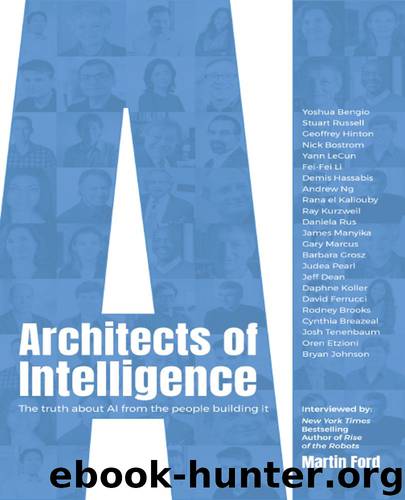Architects of Intelligence: The truth about AI from the people building it by Martin Ford

Author:Martin Ford [Ford, Martin]
Language: eng
Format: azw3
Publisher: Packt Publishing
Published: 2018-11-22T16:00:00+00:00
Chapter 13. JAMES MANYIKA
Somebody should be thinking about what the regulation of AI should look like. But I think the regulation shouldn’t start with the view that its goal is to stop AI and put back the lid on a Pandora’s box, or hold back the deployment of these technologies and try and turn the clock back.
CHAIRMAN AND DIRECTOR OF MCKINSEY GLOBAL INSTITUTE
James is a senior partner at McKinsey and Chairman of the McKinsey Global Institute, researching global economic and technology trends. James consults with the chief executives and founders of many of the world’s leading technology companies. He leads research on AI and digital technologies and their impact on organizations, work, and the global economy. James was appointed by President Obama as vice chair of the Global Development Council at the White House and by US Commerce Secretaries to the Digital Economy Board and National Innovation Board. He is on the boards of the Oxford Internet Institute, MIT’s Initiative on the Digital Economy, the Stanford-based 100-Year Study on AI, and he is a fellow at DeepMind.
MARTIN FORD: I thought we could start by having you trace your academic and career trajectory. I know you came from Zimbabwe. How did you get interested in robotics and artificial intelligence and then end up in your current role at McKinsey?
JAMES MANYIKA: I grew up in a segregated black township in what was then Rhodesia, before it became Zimbabwe. I was always inspired by the idea of science, partly because my father had been the first black Fulbright scholar from Zimbabwe to come to the United States of America in the early 1960s. While there, my father visited NASA at Cape Canaveral, where he watched rockets soar up into the sky. And in my early childhood after he came back from America, my father filled my head with the idea of science, space, and technology. So, I grew up in this segregated township, thinking about science and space, building model planes and machines out of whatever I could find.
When I got to university after the country had become Zimbabwe, my undergraduate degree was in electrical engineering with heavy doses of mathematics and computer science. And while there a visiting researcher from the University of Toronto got me involved in a project on neural networks. That’s when I learned about Rumelhart Backpropagation and the use of logisti sigmoid functions in neural network algorithms.
Fast forward, I did well enough to get a Rhodes scholarship to go to Oxford University, where I was in the Programming Research Group, working under Tony Hoare, who is best known for inventing Quicksort and for his obsession with formal methods and axiomatic specifications of programming languages. I studied for a master’s degree in mathematics and computer science and worked a lot on mathematical proofs and the development and verification of algorithms. By this time, I’d given up on the idea that I would be an astronaut, but I thought that at least if I worked on robotics and AI, I might get close to science related to space exploration.
Download
This site does not store any files on its server. We only index and link to content provided by other sites. Please contact the content providers to delete copyright contents if any and email us, we'll remove relevant links or contents immediately.
| Computer Vision & Pattern Recognition | Expert Systems |
| Intelligence & Semantics | Machine Theory |
| Natural Language Processing | Neural Networks |
Algorithms of the Intelligent Web by Haralambos Marmanis;Dmitry Babenko(16234)
Jquery UI in Action : Master the concepts Of Jquery UI: A Step By Step Approach by ANMOL GOYAL(9386)
Test-Driven Development with Java by Alan Mellor(7734)
Data Augmentation with Python by Duc Haba(7608)
Principles of Data Fabric by Sonia Mezzetta(7378)
Learn Blender Simulations the Right Way by Stephen Pearson(7294)
Microservices with Spring Boot 3 and Spring Cloud by Magnus Larsson(7137)
Hadoop in Practice by Alex Holmes(6587)
RPA Solution Architect's Handbook by Sachin Sahgal(6515)
The Infinite Retina by Robert Scoble Irena Cronin(6215)
Big Data Analysis with Python by Ivan Marin(5933)
Life 3.0: Being Human in the Age of Artificial Intelligence by Tegmark Max(5509)
Pretrain Vision and Large Language Models in Python by Emily Webber(4894)
Infrastructure as Code for Beginners by Russ McKendrick(4652)
Functional Programming in JavaScript by Mantyla Dan(4436)
WordPress Plugin Development Cookbook by Yannick Lefebvre(4381)
The Age of Surveillance Capitalism by Shoshana Zuboff(4243)
Embracing Microservices Design by Ovais Mehboob Ahmed Khan Nabil Siddiqui and Timothy Oleson(4146)
Applied Machine Learning for Healthcare and Life Sciences Using AWS by Ujjwal Ratan(4135)
